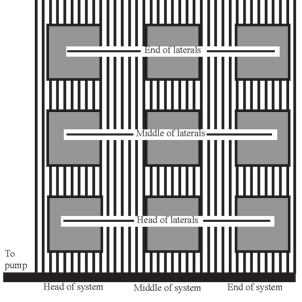How to Sample Emitters
Emitter Sampling for Emission Uniformity Determination
Drip emitters rarely discharge water at exactly the specified rate. Manufacturing differences, clogging and differences in elevation cause emitters to discharge at different rates throughout the block. Emitters through the irrigation block must be sampled for accurate and efficient irrigation scheduling. After emitters have been sampled, calculate the Emission Uniformity of the block manually, or with an interactive bilingual Excel worksheet.
Emission uniformity is expressed as a percentage (100% being completely uniform) and is calculated from measured actual discharge rates of sampled emitters.
1. Each irrigation block should be evaluated separately because blocks may be operating at different pressures.
2. Sample drip emitters at the following locations. Download a blank drip system evaluation form to record emitter discharge in the field.
|
Head of the system Middle of the system Tail end of the system
|
Sample 4 emitters at each location within block
|
In addition, you might sample at any other spots where you suspect there could be a difference in the pressure and discharge rate. For example, go to low or high elevation areas in the vineyard. More emitters than suggested above should be sampled on large irrigation blocks (greater than 20 acres).
3. Collect water from selected drip emitters. Drip emitter discharge may vary with the pressure in the drip system or clogging of emitters. For example, a 0.5 gallon per hour (gph) dripper may not actually be discharging at 0.5 gph.
4. Measure water discharged 30 seconds in a 100 ml graduated cylinder, or record the number of seconds to fill a 35 mm film canister (see Table 1 and Table 2 respectively). Use the appropriate table to convert the amount of water collected from each sampled emitter to the discharge rate in gallons/hour for that emitter.
Table 1. Determining drip emitter discharge rate in gallons per hour (gph) using a graduated cylinder.
| Milliliters of water collected in 30 seconds |
Drip emitter discharge rate (gallons/hour) |
Milliliters of water collected in 30 seconds |
Drip emitter discharge rate (gallons/hour) |
| 10 | 0.32 | 42 | 1.33 |
| 12 | 0.38 | 44 | 1.39 |
| 14 | 0.44 | 46 | 1.46 |
| 16 | 0.51 | 48 | 1.52 |
| 18 | 0.57 | 50 | 1.59 |
| 20 | 0.63 | 52 | 1.65 |
| 22 | 0.70 | 54 | 1.71 |
| 24 | 0.76 | 56 | 1.78 |
| 26 | 0.82 | 58 | 1.84 |
| 28 | 0.89 | 60 | 1.90 |
| 30 | 0.95 | 62 | 1.97 |
| 32 | 1.01 | 64 | 2.02 |
| 34 | 1.08 | 66 | 2.09 |
| 36 | 1.14 | 68 | 2.15 |
| 38 | 1.20 | 70 | 2.22 |
| 40 | 1.27 | 72 | 2.28 |
A 100 ml graduated cylinder works well. These are available online from most educational science suppliers. If possible, use a glass cylinder because it is easier to read than plastic.
Values in Table 1 were calculated using the following equation:
Drip emitter discharge rate (gph) = water collected in 30 seconds (ml) x 0.0317
Table 2. Determining drip emitter discharge rate in gallons per hour (gph) using a 35 mm film canister
| Seconds to fill a 35 mm film canister |
Drip emitter discharge rate (gallons/hour) |
Seconds to fill a 35 mm film canister |
Drip emitter discharge rate (gallons/hour) |
| 26 | 1.28 | 50 | 0.67 |
| 28 | 1.19 | 52 | 0.64 |
| 30 | 1.11 | 54 | 0.62 |
| 32 | 1.04 | 56 | 0.59 |
| 34 | 0.98 | 58 | 0.57 |
| 36 | 0.92 | 60 | 0.55 |
| 38 | 0.88 | 62 | 0.54 |
| 40 | 0.83 | 64 | 0.52 |
| 42 | 0.79 | 66 | 0.50 |
| 44 | 0.76 | 68 | 0.49 |
| 46 | 0.72 | 70 | 0.48 |
| 48 | 0.69 | 72 | 0.46 |
Values in Table 2 were calculated using the following equation:
Drip emitter discharge rate (gph) = 33.29 ÷ Time to fill 35 mm film canister (seconds)


